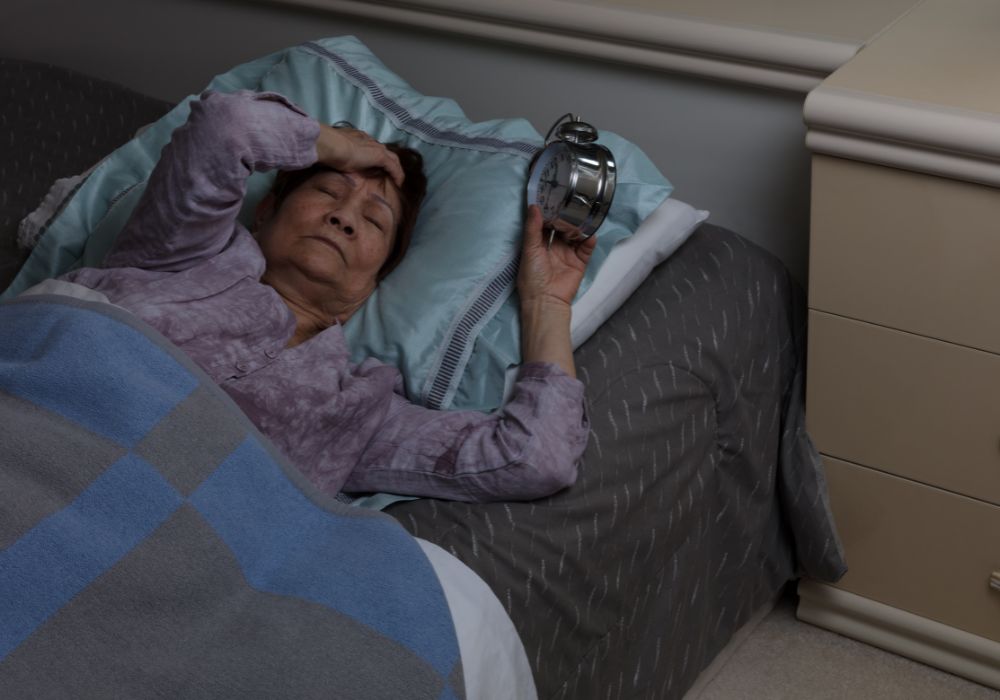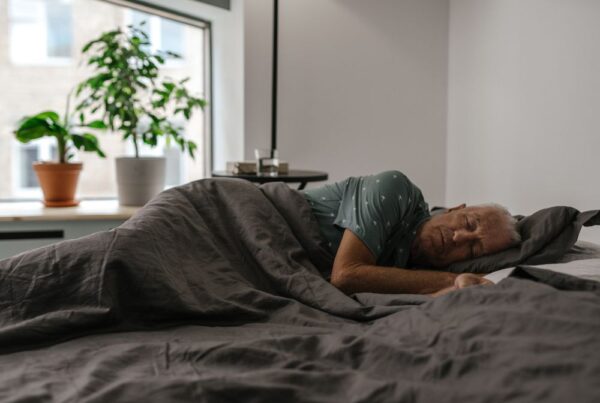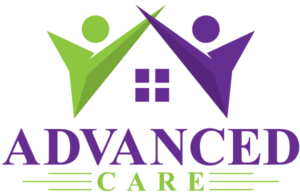Key Takeaways
- Sleep apnea is common in seniors and can lead to severe health complications if untreated.
- Signs include loud snoring, daytime fatigue, memory issues, and morning headaches.
- CPAP therapy is the most effective treatment, but lifestyle changes, oral appliances, and surgery are also options.
- Home adjustments like elevating the bed and optimizing sleep environment can improve symptoms.
- Advanced Care provides specialized support, including equipment management, sleep environment optimization, and lifestyle coaching.
How Can Seniors Manage Sleep Apnea?
Sleep apnea is a serious sleep disorder that affects many seniors, often causing fatigue, memory issues, and increased health risks. Treatment options include CPAP therapy, lifestyle changes, and home adjustments to improve sleep quality and overall well-being.
Addressing Sleep Apnea in Seniors: Signs, Treatments, and Home Adjustments
Sleep apnea is a serious but often overlooked condition that affects millions of seniors. Characterized by repeated interruptions in breathing during sleep, this disorder can lead to severe health complications if left untreated. Many older adults may not even realize they have sleep apnea, attributing their fatigue, memory issues, or morning headaches to normal aging. At Advanced Care, we recognize the importance of identifying and managing sleep apnea in seniors to promote better overall health and quality of life. In this blog, we’ll explore the signs of sleep apnea, available treatments, and home adjustments that can improve sleep quality.
Understanding Sleep Apnea in Seniors
Sleep apnea is a sleep disorder that causes a person’s breathing to stop and start repeatedly throughout the night. The most common type in seniors is obstructive sleep apnea (OSA), which occurs when the muscles in the throat relax excessively and block the airway. Another less common type, central sleep apnea (CSA), occurs when the brain fails to send proper signals to the muscles that control breathing.
Prevalence and Risk Factors in Older Adults
Sleep apnea becomes increasingly common as we age, with studies suggesting that between 30-60% of older adults may experience some form of sleep-disordered breathing. Several factors contribute to the higher prevalence among seniors:
- Physiological Changes: As we age, muscle tone decreases throughout the body, including in the throat. This natural loss of muscle tone can lead to increased airway collapse during sleep.
- Weight Changes: Many seniors experience changes in body composition, with increased fat deposits around the neck and throat that can restrict airway passage.
- Medication Effects: Certain medications commonly prescribed to older adults, such as muscle relaxants, sedatives, and some pain medications, can relax throat muscles and worsen sleep apnea symptoms.
- Anatomical Factors: Natural changes in facial structure, including retrognathia (recessed jaw) and enlarged tongue or tonsils, can narrow the upper airway.
- Comorbid Conditions: Conditions common in older age, such as heart failure, stroke, and diabetes, are associated with higher rates of sleep apnea.
- Gender Shifts: While sleep apnea is more common in men during middle age, the gap narrows after menopause, with postmenopausal women experiencing nearly equivalent rates to men.
Types of Sleep Apnea and Their Mechanisms
Understanding the different types of sleep apnea is crucial for appropriate treatment:
Obstructive Sleep Apnea (OSA): This most common form occurs when throat muscles relax during sleep, allowing the tongue and soft tissues to collapse and block the airway. Each blockage, or apnea, temporarily cuts off breathing and typically lasts 10-30 seconds but can persist for a minute or longer in severe cases. These interruptions can occur 5-30 times or more each hour, dramatically affecting sleep quality.
Central Sleep Apnea (CSA): Less common but more prevalent in older adults with heart or neurological conditions, CSA occurs when the brain fails to transmit signals to the breathing muscles. Unlike OSA, there’s no effort to breathe during episodes. CSA is often associated with conditions such as heart failure, stroke, or brain tumors, and may also occur as a result of certain medications, particularly strong opioid painkillers.
Complex/Mixed Sleep Apnea: Some seniors experience a combination of both obstructive and central sleep apnea, known as complex or mixed sleep apnea. Initially presenting as OSA, some patients develop central apnea components, especially after beginning CPAP treatment.
Both types of sleep apnea disrupt normal sleep patterns and can lead to long-term health issues, including cardiovascular disease, cognitive decline, and increased fall risk due to fatigue. The frequent drops in blood oxygen levels and repeated nighttime awakenings place significant stress on the body and brain, contributing to a range of health problems.
Common Signs and Symptoms of Sleep Apnea in Seniors
Sleep apnea can be difficult to recognize, especially in seniors who sleep alone or who may not notice their nighttime symptoms. However, family members or caregivers may observe warning signs such as:
- Loud, chronic snoring (often with pauses in breathing)
- Gasping or choking during sleep
- Excessive daytime fatigue or frequent napping
- Morning headaches
- Dry mouth or sore throat upon waking
- Difficulty concentrating or memory problems
- Restless or fragmented sleep
- Frequent nighttime urination (nocturia)
- Mood changes, including irritability, depression, or anxiety
- Decreased interest in activities due to fatigue
- Observed breathing pauses during sleep, often noticed by a partner
- Excessive movement during sleep
- Awakening with a sensation of choking or gasping
- Insomnia or difficulty staying asleep
- Reduced libido or sexual dysfunction
Unique Presentation in Seniors
Sleep apnea may present differently in older adults compared to younger populations. Seniors are less likely to report classic symptoms like daytime sleepiness and may instead attribute their symptoms to “normal aging.” They might describe:
- Increased fatigue but not necessarily sleepiness
- Greater difficulty with balance and coordination
- More pronounced cognitive effects, including confusion or disorientation
- Increased frequency of nighttime urination
- Subtler mood changes that may be mistaken for depression
- Falls or increased fall risk due to fatigue and impaired coordination
If left untreated, sleep apnea can contribute to high blood pressure, heart disease, diabetes, stroke, and cognitive impairment. Seniors experiencing these symptoms should speak with their doctor to discuss potential sleep apnea evaluation.
The Serious Health Consequences of Untreated Sleep Apnea
Untreated sleep apnea creates a cascade of health issues that are particularly problematic for older adults:
Cardiovascular Complications
- Hypertension: The repeated drops in blood oxygen levels during apnea episodes trigger increases in blood pressure that can persist during waking hours.
- Arrhythmias: Irregular heart rhythms, particularly atrial fibrillation, are strongly associated with sleep apnea.
- Heart Failure: Sleep apnea places extra stress on the heart, potentially exacerbating or contributing to heart failure.
- Coronary Artery Disease: Studies show sleep apnea increases the risk of coronary artery disease, heart attacks, and stroke.
- Pulmonary Hypertension: Persistent high pressure in the lung arteries can develop as a result of sleep apnea.
Neurological and Cognitive Impacts
- Cognitive Decline: Repeated drops in oxygen saturation can damage brain tissue over time.
- Increased Dementia Risk: Research indicates that sleep apnea is associated with earlier onset and more rapid progression of cognitive disorders.
- Poor Executive Function: Decision-making, planning, and problem-solving abilities may be compromised.
- Daytime Cognitive Impairment: Concentration, attention, and memory are frequently affected.
Additional Health Concerns
- Metabolic Disorders: Sleep apnea is linked to insulin resistance, glucose intolerance, and Type 2 diabetes.
- Respiratory Failure: Severe, untreated sleep apnea can eventually lead to respiratory failure in vulnerable individuals.
- Liver Problems: Non-alcoholic fatty liver disease is more common in those with sleep apnea.
- Medication Resistance: Some conditions, such as hypertension, may become resistant to medication when sleep apnea is present but untreated.
- Post-surgical Complications: Seniors with undiagnosed sleep apnea face higher risks during and after surgery.
Quality of Life Impact
Beyond specific health conditions, untreated sleep apnea significantly diminishes quality of life for seniors through:
- Chronic fatigue affecting daily activities
- Social withdrawal due to excessive tiredness
- Increased dependence on caregivers
- Reduced participation in enjoyable activities
- Strained relationships due to sleep disruption of bed partners
- Loss of independence due to cognitive impacts
Diagnosing Sleep Apnea in Seniors
If sleep apnea is suspected, a healthcare provider may recommend a sleep study to assess breathing patterns and oxygen levels during sleep. This can be done in a sleep laboratory or at home with a portable sleep apnea test. These tests monitor breathing, airflow, oxygen levels, and movement to determine the severity of the condition.
Types of Sleep Studies
Polysomnography (PSG): This comprehensive sleep study is conducted in a sleep laboratory and monitors multiple parameters including:
- Brain waves (EEG)
- Eye movements
- Heart rate and rhythm
- Breathing patterns
- Blood oxygen levels
- Limb movements
- Snoring and airflow
PSG is considered the gold standard for diagnosing sleep apnea but may present challenges for seniors with mobility issues or those who experience anxiety in unfamiliar environments.
Home Sleep Apnea Test (HSAT): A simplified version of sleep testing that can be conducted in the comfort of a senior’s own home. While less comprehensive than PSG, HSATs monitor:
- Airflow
- Breathing effort
- Blood oxygen levels
- Heart rate
- Sleep position
HSATs are increasingly used for seniors due to their convenience, though they may underestimate the severity of sleep apnea in some cases.
The Apnea-Hypopnea Index (AHI)
Sleep studies measure the number of breathing interruptions per hour, known as the Apnea-Hypopnea Index (AHI):
- Mild sleep apnea: AHI of 5-15 events per hour
- Moderate sleep apnea: AHI of 15-30 events per hour
- Severe sleep apnea: AHI greater than 30 events per hour
However, it’s important to note that seniors may experience significant symptoms and health consequences even with relatively low AHI scores. Age-related vulnerability means that even mild sleep apnea can have substantial impacts on overall health and quality of life in older adults.
Barriers to Diagnosis in Seniors
Several factors can complicate the diagnosis of sleep apnea in the elderly:
- Atypical Presentation: As mentioned earlier, seniors may not report classic symptoms like excessive daytime sleepiness.
- Attribution to Aging: Both patients and clinicians may mistakenly attribute symptoms to “normal aging” rather than a treatable condition.
- Comorbid Conditions: Other health problems may mask or mimic sleep apnea symptoms.
- Polypharmacy: Multiple medications can influence sleep patterns and breathing, complicating diagnosis.
- Accessibility Issues: Transportation challenges, mobility limitations, or cognitive impairment may make traditional sleep studies difficult.
Once diagnosed, seniors can explore treatment options to improve their sleep and overall well-being.
Treatment Options for Sleep Apnea
Managing sleep apnea requires a combination of lifestyle changes, medical treatments, and in some cases, surgical interventions. Common treatment options include:
1. Continuous Positive Airway Pressure (CPAP) Therapy
A CPAP machine delivers a steady stream of air through a mask to keep the airway open. This is the most effective treatment for obstructive sleep apnea and helps reduce snoring, improve sleep quality, and lower health risks. However, some seniors find CPAP uncomfortable and may need time to adjust.
Benefits for Seniors:
- Immediate reduction in apnea events when used correctly
- Improved oxygen levels throughout the night
- Reduced risk of cardiovascular complications
- Better cognitive function and mood
- Decreased nocturia (nighttime urination)
- Improved daytime alertness and energy
Challenges for Seniors:
- Mask discomfort or claustrophobia
- Difficulty adjusting to pressure
- Skin irritation or pressure sores
- Dry mouth or nasal passages
- Difficulty operating equipment with arthritis or vision problems
- Remembering to use consistently
Improving CPAP Adherence:
- Trying different mask styles and sizes for better comfort
- Using a humidifier to prevent dryness
- Starting with a “ramp” feature that gradually increases pressure
- Using CPAP during naps to increase familiarity
- Getting regular follow-up to address issues promptly
- Ensuring proper mask fit and equipment maintenance
2. Bi-Level Positive Airway Pressure (BiPAP) Therapy
For seniors who struggle with CPAP, BiPAP machines provide different pressure levels for inhalation and exhalation, making breathing more comfortable. This is particularly helpful for:
- Seniors with COPD or other respiratory conditions
- Those who feel suffocated by continuous pressure
- Patients with central sleep apnea components
- Those requiring higher pressure settings
BiPAP may be easier to tolerate because the lower pressure during exhalation reduces the feeling of fighting against the machine.
3. Adaptive Servo-Ventilation (ASV)
ASV is a more advanced form of PAP therapy specifically designed for complex sleep apnea and central sleep apnea. The machine “learns” the patient’s breathing pattern and adjusts pressure dynamically to normalize breathing. This can be particularly effective for seniors with heart failure or neurological conditions that affect breathing patterns, though it’s contraindicated in some patients with severely reduced heart function.
4. Oral Appliance Therapy
Custom-fitted oral appliances, prescribed by a dentist specialized in sleep medicine, reposition the jaw and tongue to prevent airway collapse during sleep. This option is ideal for seniors with mild to moderate sleep apnea who cannot tolerate CPAP therapy.
Types of Oral Appliances:
- Mandibular Advancement Devices (MADs): Reposition the lower jaw forward to open the airway
- Tongue Retaining Devices: Hold the tongue in a forward position to prevent airway blockage
Considerations for Seniors:
- Requires sufficient teeth for anchoring the device
- May cause temporary jaw pain or tooth discomfort
- Easier to transport when traveling compared to CPAP
- Less effective than CPAP for severe sleep apnea
- Typically requires less adjustment period than CPAP
- May be affected by dentures or dental work
5. Lifestyle Modifications
Simple lifestyle changes can reduce the severity of sleep apnea:
Weight Management: Excess weight increases airway obstruction. Losing even a small amount of weight (5-10% of body weight) can significantly improve symptoms. For seniors, this should involve a gentle, medically supervised approach focused on healthy eating and appropriate physical activity.
Sleeping Position Adjustments: Sleeping on the side rather than the back can help keep the airway open. Positional therapy using special pillows, positional alarms, or tennis balls sewn into the back of sleep clothes can help maintain side sleeping.
Avoiding Alcohol and Sedatives: These substances relax the muscles in the throat, worsening sleep apnea. Seniors should avoid alcohol within 3 hours of bedtime and discuss sedative medications with their healthcare provider.
Establishing a Consistent Sleep Schedule: Going to bed and waking up at the same time every day supports better sleep quality and can reduce the frequency of apnea episodes.
Treating Nasal Congestion: Addressing allergies, sinus issues, or structural problems that cause nasal congestion can improve airflow and reduce sleep apnea severity.
Smoking Cessation: Smoking causes inflammation and fluid retention in the upper airway, exacerbating sleep apnea. Quitting can lead to significant improvement in symptoms.
6. Surgical Interventions
In severe cases where other treatments fail, surgery may be an option. Procedures may include:
Uvulopalatopharyngoplasty (UPPP): Removes excess tissue from the throat to widen the airway. While potentially effective, it requires careful patient selection and may not be appropriate for many seniors due to surgical risks.
Maxillomandibular Advancement: Repositions the jaw to enlarge the space behind the tongue and soft palate. This more invasive procedure has higher success rates but longer recovery times.
Hypoglossal Nerve Stimulation: Involves implanting a device that stimulates the nerve controlling tongue movement to prevent airway collapse during sleep. This newer technology shows promise for seniors who cannot use CPAP but need effective treatment.
Nasal Surgery: Addresses structural problems such as deviated septum or nasal polyps that contribute to breathing difficulties.
Surgical options require careful consideration of the senior’s overall health, recovery ability, and life expectancy relative to the intervention’s benefits.
Home Adjustments for Seniors with Sleep Apnea
Creating a sleep-friendly environment can make a significant difference for seniors managing sleep apnea. Consider the following home adjustments:
1. Elevate the Head of the Bed
Raising the head of the bed by 4-6 inches or using a wedge pillow can help keep the airway open and reduce nighttime breathing difficulties. This position uses gravity to keep the tongue and soft palate from collapsing into the airway. Options include:
- Adjustable beds with head elevation features
- Bed wedges designed specifically for this purpose
- Reliable bed risers under the headboard legs
- Hospital-style beds for seniors with additional mobility needs
This adjustment can be particularly helpful for seniors with heart failure or acid reflux in addition to sleep apnea.
2. Invest in a CPAP-Friendly Sleep Space
Seniors using CPAP machines should have a dedicated nightstand for easy access to their device. Keeping the CPAP mask clean and properly fitted enhances comfort and effectiveness. Consider:
- Placing the CPAP machine at or below bed level to prevent tubing pull
- Using a hose holder or suspended system to manage tubing
- Installing a power outlet with backup battery capability for power outages
- Creating easy access to water for humidifier refills
- Using CPAP cleaning wipes or devices for simple maintenance
- Ensuring adequate space for eyeglasses, denture cups, and CPAP equipment
- Using a small night light for middle-of-the-night adjustments without disrupting sleep
3. Optimize Bedroom Air Quality
Using a humidifier can reduce nasal congestion and throat irritation, making breathing easier. Seniors with allergies should also consider air purifiers to remove dust and allergens that may worsen breathing issues. Additional considerations include:
- Maintaining optimal humidity levels (40-50%) to prevent airway dryness
- Regular cleaning to reduce dust mites and allergens
- Removing carpeting if possible, or using low-pile carpeting
- Using hypoallergenic bedding and pillow covers
- Avoiding scented products that may irritate airways
- Keeping windows closed during high pollen seasons
- Regular replacement of HVAC filters
4. Minimize Noise and Light Disruptions
Creating a quiet, dark, and cool sleeping environment helps seniors fall and stay asleep. Blackout curtains, white noise machines, and comfortable bedding can enhance sleep quality. Specific recommendations include:
- Room-darkening curtains or shades to block streetlights or early morning sun
- Removing or covering electronic lights from devices
- Using a white noise machine to mask environmental sounds
- Maintaining bedroom temperature between 65-70°F (18-21°C)
- Selecting comfortable, breathable bedding appropriate for the season
- Considering separate blankets for couples with different temperature preferences
- Using earplugs if noise disruption persists despite other measures
5. Implement a Bedtime Routine
Encouraging seniors to wind down before bed with relaxation techniques—such as deep breathing, meditation, or gentle stretching—can improve sleep consistency and reduce stress. A consistent routine helps signal to the body that it’s time for sleep:
- Beginning the wind-down process 30-60 minutes before bedtime
- Avoiding screens (TV, phone, tablet) for at least an hour before sleep
- Creating a consistent sequence of activities (washing up, changing clothes, reading)
- Practicing relaxation techniques such as progressive muscle relaxation
- Avoiding stressful conversations or activities before bed
- Using aromatherapy such as lavender, if tolerated and enjoyed
- Limiting fluid intake in the hours before bedtime to reduce nighttime awakening
6. Bedroom Furniture and Layout Considerations
The arrangement of furniture and accessibility features can support better sleep for seniors with sleep apnea:
- Bed height that allows easy entry and exit without straining
- Nightstands at appropriate heights for easy access to CPAP and other necessities
- Clear pathways for safe navigation during nighttime awakening
- Sturdy grab bars or bed rails if needed for safety
- Comfortable seating for putting on CPAP mask or performing bedtime routines
- Adequate lighting for safety that can be easily dimmed or turned off from bed
- Avoiding overcrowded spaces that collect dust and allergens
The Link Between Sleep Apnea and Cognitive Health
Untreated sleep apnea has been linked to cognitive decline and an increased risk of dementia in seniors. Poor sleep quality affects memory, attention, and decision-making. By addressing sleep apnea early, seniors can improve brain function and maintain mental sharpness.
Mechanisms of Cognitive Impact
Sleep apnea affects brain health through several pathways:
- Intermittent Hypoxia: Repeated drops in oxygen levels during apnea episodes can damage brain cells over time.
- Sleep Fragmentation: Constant micro-awakenings prevent the deep, restorative sleep necessary for cognitive function and memory consolidation.
- Inflammation: Sleep apnea triggers inflammatory processes that may contribute to neurodegeneration.
- Blood-Brain Barrier Disruption: Research suggests that sleep apnea may compromise the blood-brain barrier, allowing harmful substances to reach brain tissue.
- Reduced Glymphatic Clearance: The brain’s waste clearance system, which removes proteins like beta-amyloid, functions primarily during deep sleep—which is severely limited in sleep apnea.
Evidence of Cognitive Benefits from Treatment
Studies have shown that consistent CPAP use can improve cognitive function, mood, and overall well-being in seniors with sleep apnea. This underscores the importance of seeking treatment and making necessary lifestyle adjustments. Research findings include:
- Improvements in attention and executive function within 3-6 months of consistent treatment
- Better verbal memory and recall abilities
- Reduced daytime sleepiness leading to improved functional performance
- Stabilization of cognitive function in those at risk for decline
- Improved problem-solving abilities and processing speed
- Enhanced mood and reduced depression symptoms
- Potentially slowed progression of existing mild cognitive impairment
These benefits appear to be most pronounced when treatment begins early and adherence is consistent, highlighting the importance of prompt diagnosis and effective management.
How Advanced Care Supports Seniors with Sleep Apnea
At Advanced Care, we recognize the challenges that sleep apnea presents for seniors and their families. Our caregivers can assist with:
1. Equipment Management and Compliance
- Reminding seniors to use their CPAP or BiPAP machines
- Assisting with proper mask placement and adjustment
- Helping with equipment cleaning and maintenance
- Tracking usage to identify and address adherence issues
- Providing encouragement and positive reinforcement
2. Sleep Environment Optimization
- Helping create a sleep-friendly environment
- Ensuring proper bed positioning and pillow arrangement
- Maintaining appropriate room temperature and humidity
- Reducing noise and light disturbances
- Assisting with positional therapy techniques
3. Health Monitoring and Management
- Monitoring signs of sleep apnea and assisting with medical follow-ups
- Tracking symptoms and improvements
- Recognizing complications or worsening symptoms
- Coordinating with healthcare providers
- Accompanying seniors to sleep specialist appointments
- Maintaining records of sleep quality and daytime symptoms
4. Lifestyle Support
- Encouraging lifestyle habits that support better sleep
- Assistance with weight management efforts
- Preparing sleep-friendly meals and snacks
- Encouraging appropriate physical activity
- Supporting smoking cessation efforts
- Monitoring medication timing to optimize sleep
5. Emotional and Psychological Support
- Providing companionship and reassurance
- Reducing anxiety about using sleep equipment
- Offering encouragement during the adjustment period
- Supporting overall mental well-being
- Facilitating communication with family members about care needs
We are committed to providing personalized care that prioritizes senior health and well-being, with a holistic approach that recognizes the importance of quality sleep for overall health. Learn more about our services designed specifically for seniors with sleep and health challenges.
Final Thoughts
Sleep apnea is a serious condition that can significantly impact a senior’s quality of life and long-term health. Recognizing the symptoms, seeking appropriate treatment, and making simple home adjustments can help seniors achieve restful, restorative sleep. The benefits extend beyond simply feeling more rested—proper sleep apnea management can improve heart health, enhance cognitive function, reduce fall risk, and generally support a higher quality of life in the senior years.
By taking a proactive approach to sleep health, seniors can address sleep apnea before it leads to serious complications. Family members and caregivers play a crucial role in identifying potential symptoms and supporting treatment adherence.
At Advanced Care, we are here to support seniors and their families in managing sleep apnea and improving overall well-being. If you or a loved one needs assistance with sleep health, Contact Us today to learn more about our services.






